Top companies trust Airbyte to centralize their Data









This includes selecting the data you want to extract - streams and columns -, the sync frequency, where in the destination you want that data to be loaded.




This includes selecting the data you want to extract - streams and columns -, the sync frequency, where in the destination you want that data to be loaded.

Set up a source connector to extract data from in Airbyte
Choose from one of 300+ sources where you want to import data from. This can be any API tool, cloud data warehouse, database, data lake, files, among other source types. You can even build your own source connector in minutes with our no-code connector builder.


Configure the connection in Airbyte
Ship more quickly with the only solution that fits ALL your needs.
As your tools and edge cases grow, you deserve an extensible and open ELT solution that eliminates the time you spend on building and maintaining data pipelines
Leverage the largest catalog of connectors
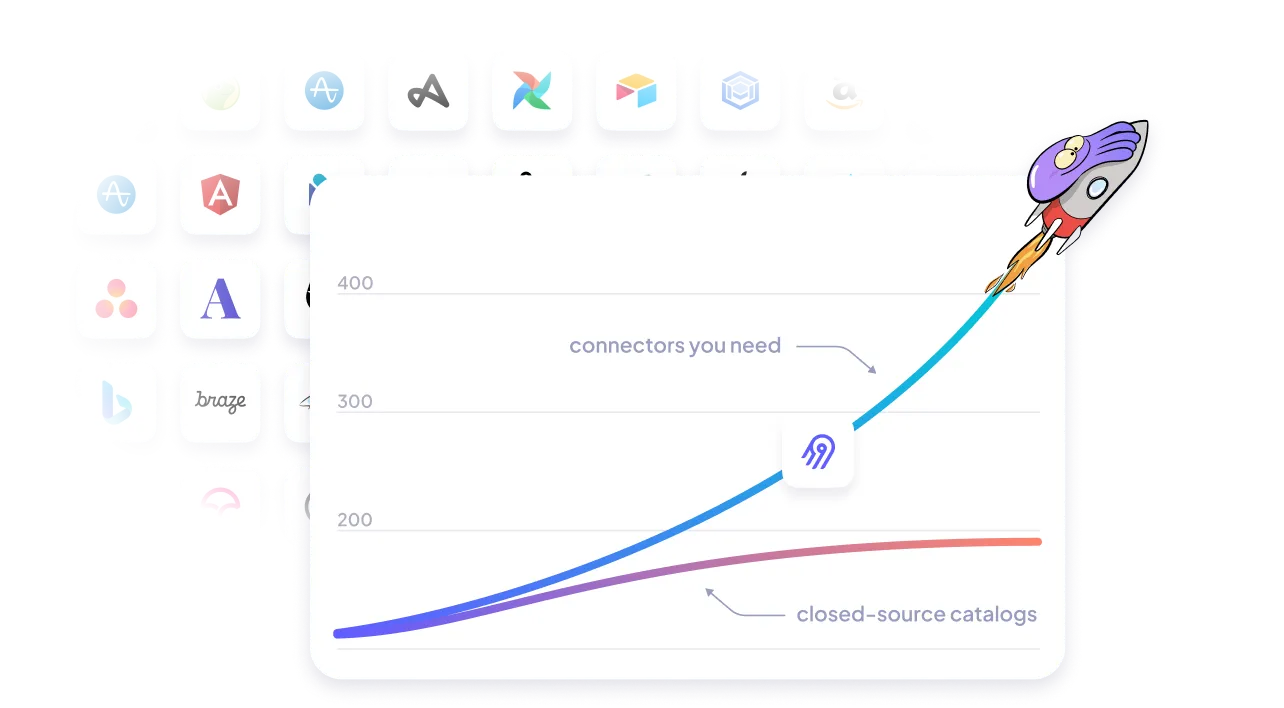
Cover your custom needs with our extensibility
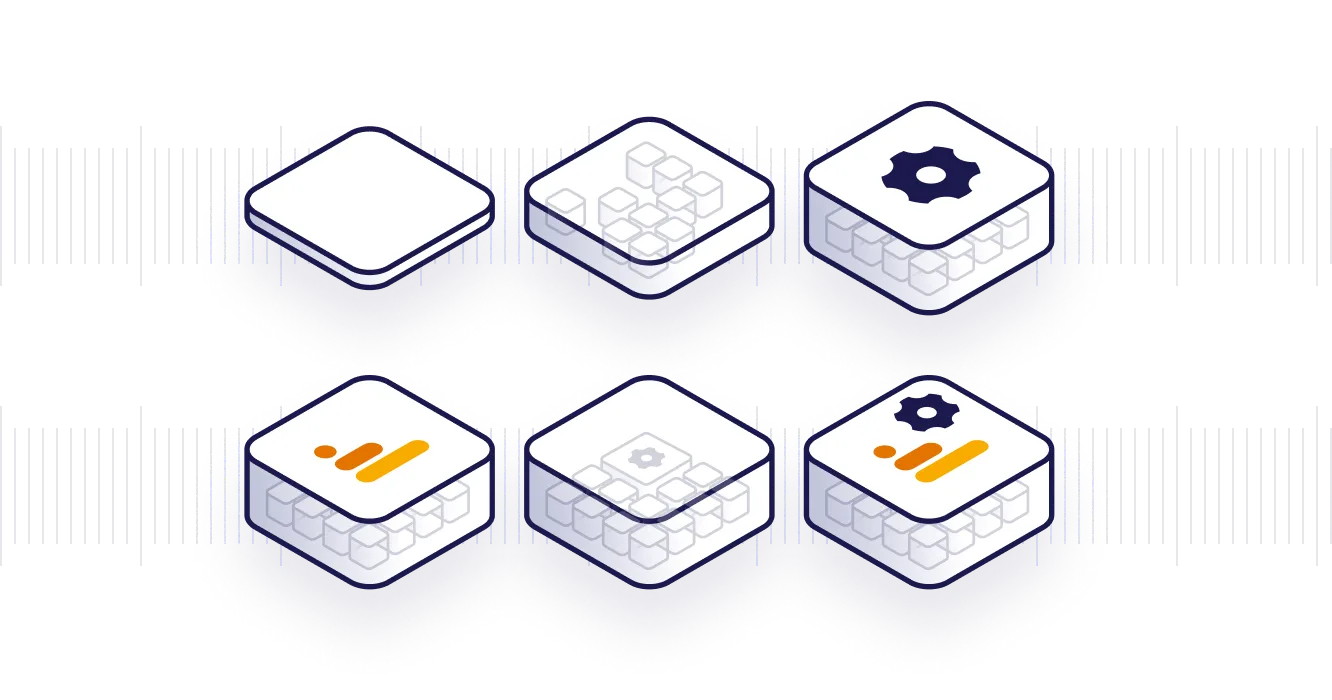
Free your time from maintaining connectors, with automation
- Automated schema change handling, data normalization and more
- Automated data transformation orchestration with our dbt integration
- Automated workflow with our Airflow, Dagster and Prefect integration
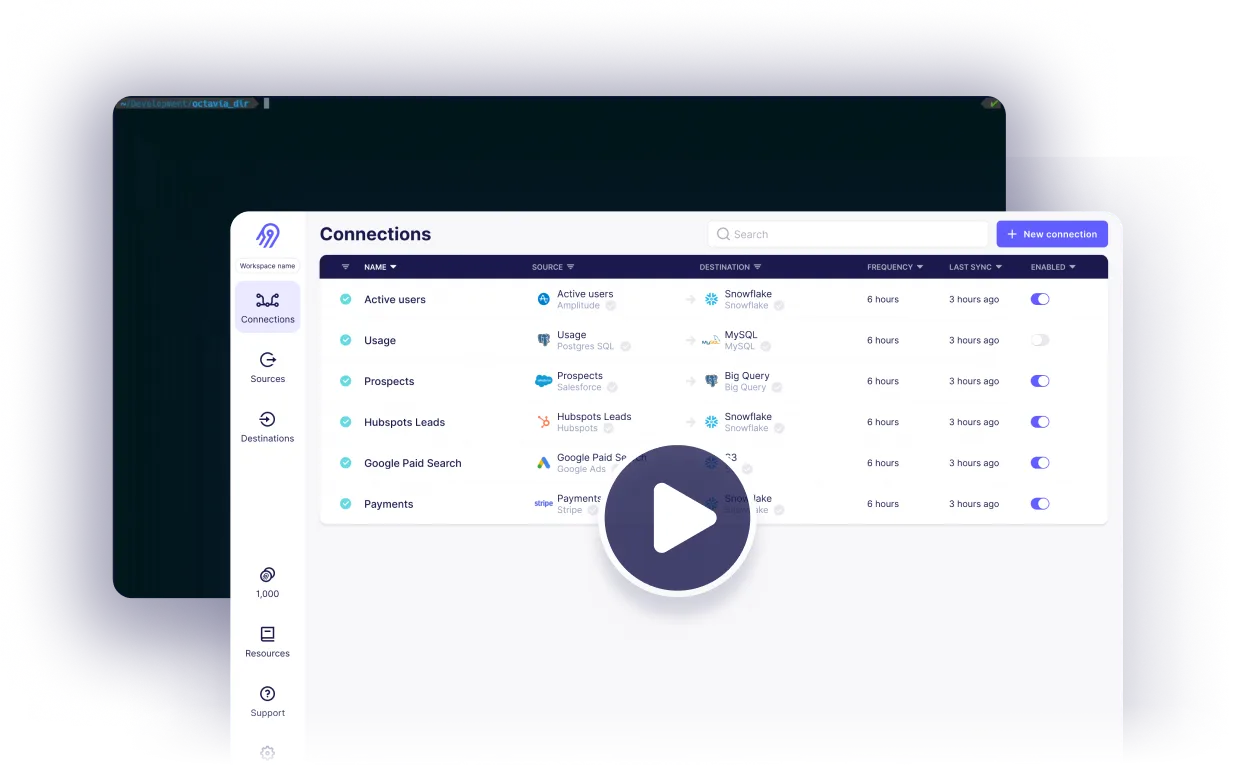
Reliability at every level



Ship more quickly with the only solution that fits ALL your needs.
As your tools and edge cases grow, you deserve an extensible and open ELT solution that eliminates the time you spend on building and maintaining data pipelines
Leverage the largest catalog of connectors

Cover your custom needs with our extensibility

Free your time from maintaining connectors, with automation
- Automated schema change handling, data normalization and more
- Automated data transformation orchestration with our dbt integration
- Automated workflow with our Airflow, Dagster and Prefect integration

Reliability at every level



Ship more quickly with the only solution that fits ALL your needs.
As your tools and edge cases grow, you deserve an extensible and open ELT solution that eliminates the time you spend on building and maintaining data pipelines
Leverage the largest catalog of connectors

Cover your custom needs with our extensibility

Free your time from maintaining connectors, with automation
- Automated schema change handling, data normalization and more
- Automated data transformation orchestration with our dbt integration
- Automated workflow with our Airflow, Dagster and Prefect integration

Reliability at every level



Move large volumes, fast.
Change Data Capture.
Security from source to destination.

We support the CDC methods your company needs
Log-based CDC



Timestamp-based CDC


Airbyte Open Source


Airbyte Cloud


Airbyte Enterprise

Why choose Airbyte as the backbone of your data infrastructure?
Keep your data engineering costs in check
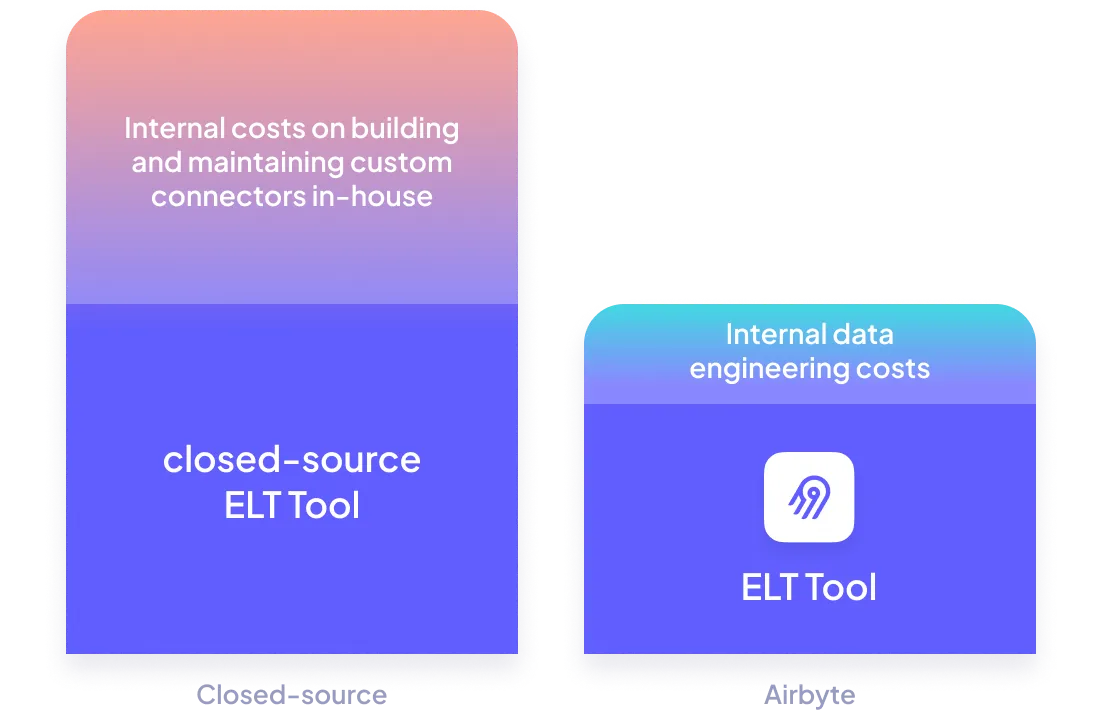
Get Airbyte hosted where you need it to be
- Airbyte Cloud: Have it hosted by us, with all the security you need (SOC2, ISO, GDPR, HIPAA Conduit).
- Airbyte Enterprise: Have it hosted within your own infrastructure, so your data and secrets never leave it.

White-glove enterprise-level support
Including for your Airbyte Open Source instance with our premium support.
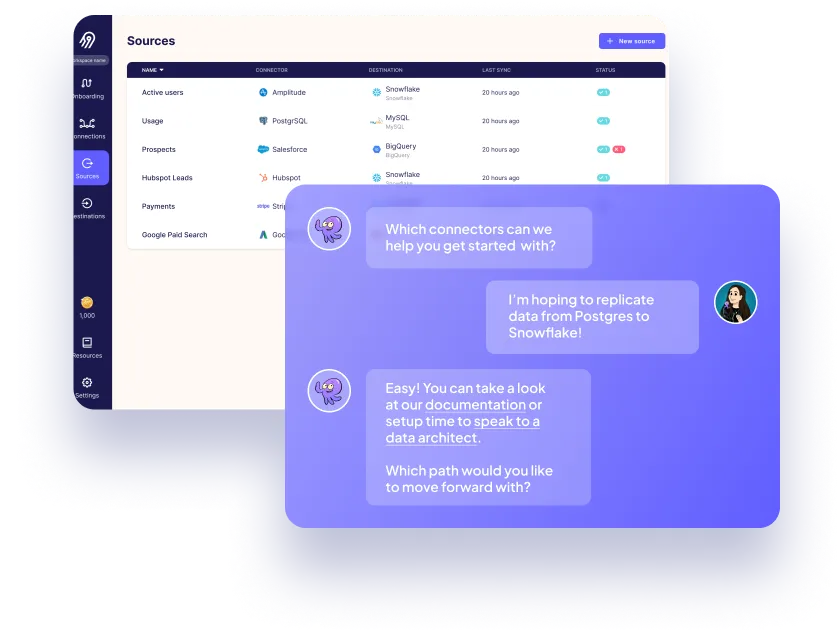
Airbyte supports a growing list of destinations, including cloud data warehouses, lakes, and databases.
Airbyte supports a growing list of destinations, including cloud data warehouses, lakes, and databases.
Airbyte supports a growing list of sources, including API tools, cloud data warehouses, lakes, databases, and files, or even custom sources you can build.



Fnatic, based out of London, is the world's leading esports organization, with a winning legacy of 16 years and counting in over 28 different titles, generating over 13m USD in prize money. Fnatic has an engaged follower base of 14m across their social media platforms and hundreds of millions of people watch their teams compete in League of Legends, CS:GO, Dota 2, Rainbow Six Siege, and many more titles every year.
Ready to get started?
FAQs
What is ETL?
ETL, an acronym for Extract, Transform, Load, is a vital data integration process. It involves extracting data from diverse sources, transforming it into a usable format, and loading it into a database, data warehouse or data lake. This process enables meaningful data analysis, enhancing business intelligence.
Xero is the online accounting software for your business which connects you to your accountant, bank, bookkeeper, and other business apps. Xero is an well known accounting system that have designed for small and growing businesses with their trusted advisors. You don't need to have an accounting degree to use the Xero Accounting app for a small business owner. It is also a cloud-based small business accounting software having tools for managing bank reconciliation, inventory, invoicing, purchasing, expenses.
Xero's API provides access to a wide range of data related to accounting and financial management. The following are the categories of data that can be accessed through Xero's API:
1. Contacts: This includes information about customers, suppliers, and employees.
2. Invoices: This includes details about invoices, such as invoice numbers, dates, amounts, and payment status.
3. Bills: This includes information about bills, such as bill numbers, dates, amounts, and payment status.
4. Bank transactions: This includes details about bank transactions, such as deposits, withdrawals, and transfers.
5. Inventory: This includes information about inventory items, such as stock levels, prices, and descriptions.
6. Payroll: This includes information about employee payroll, such as salaries, taxes, and benefits.
7. Reports: This includes various financial reports, such as balance sheets, income statements, and cash flow statements.
8. Tracking categories: This includes information about tracking categories, which are used to categorize transactions and generate reports.
9. Settings: This includes various settings related to the Xero account, such as company information, user permissions, and tax settings.
What is ELT?
ELT, standing for Extract, Load, Transform, is a modern take on the traditional ETL data integration process. In ELT, data is first extracted from various sources, loaded directly into a data warehouse, and then transformed. This approach enhances data processing speed, analytical flexibility and autonomy.
Difference between ETL and ELT?
ETL and ELT are critical data integration strategies with key differences. ETL (Extract, Transform, Load) transforms data before loading, ideal for structured data. In contrast, ELT (Extract, Load, Transform) loads data before transformation, perfect for processing large, diverse data sets in modern data warehouses. ELT is becoming the new standard as it offers a lot more flexibility and autonomy to data analysts.
What is ETL?
ETL, an acronym for Extract, Transform, Load, is a vital data integration process. It involves extracting data from diverse sources, transforming it into a usable format, and loading it into a database, data warehouse or data lake. This process enables meaningful data analysis, enhancing business intelligence.
Xero is the online accounting software for your business which connects you to your accountant, bank, bookkeeper, and other business apps. Xero is an well known accounting system that have designed for small and growing businesses with their trusted advisors. You don't need to have an accounting degree to use the Xero Accounting app for a small business owner. It is also a cloud-based small business accounting software having tools for managing bank reconciliation, inventory, invoicing, purchasing, expenses.
Xero's API provides access to a wide range of data related to accounting and financial management. The following are the categories of data that can be accessed through Xero's API:
1. Contacts: This includes information about customers, suppliers, and employees.
2. Invoices: This includes details about invoices, such as invoice numbers, dates, amounts, and payment status.
3. Bills: This includes information about bills, such as bill numbers, dates, amounts, and payment status.
4. Bank transactions: This includes details about bank transactions, such as deposits, withdrawals, and transfers.
5. Inventory: This includes information about inventory items, such as stock levels, prices, and descriptions.
6. Payroll: This includes information about employee payroll, such as salaries, taxes, and benefits.
7. Reports: This includes various financial reports, such as balance sheets, income statements, and cash flow statements.
8. Tracking categories: This includes information about tracking categories, which are used to categorize transactions and generate reports.
9. Settings: This includes various settings related to the Xero account, such as company information, user permissions, and tax settings.
What is ELT?
ELT, standing for Extract, Load, Transform, is a modern take on the traditional ETL data integration process. In ELT, data is first extracted from various sources, loaded directly into a data warehouse, and then transformed. This approach enhances data processing speed, analytical flexibility and autonomy.
Difference between ETL and ELT?
ETL and ELT are critical data integration strategies with key differences. ETL (Extract, Transform, Load) transforms data before loading, ideal for structured data. In contrast, ELT (Extract, Load, Transform) loads data before transformation, perfect for processing large, diverse data sets in modern data warehouses. ELT is becoming the new standard as it offers a lot more flexibility and autonomy to data analysts.
What is ETL?
ETL, an acronym for Extract, Transform, Load, is a vital data integration process. It involves extracting data from diverse sources, transforming it into a usable format, and loading it into a database, data warehouse or data lake. This process enables meaningful data analysis, enhancing business intelligence.
Xero is the online accounting software for your business which connects you to your accountant, bank, bookkeeper, and other business apps. Xero is an well known accounting system that have designed for small and growing businesses with their trusted advisors. You don't need to have an accounting degree to use the Xero Accounting app for a small business owner. It is also a cloud-based small business accounting software having tools for managing bank reconciliation, inventory, invoicing, purchasing, expenses.
Xero's API provides access to a wide range of data related to accounting and financial management. The following are the categories of data that can be accessed through Xero's API:
1. Contacts: This includes information about customers, suppliers, and employees.
2. Invoices: This includes details about invoices, such as invoice numbers, dates, amounts, and payment status.
3. Bills: This includes information about bills, such as bill numbers, dates, amounts, and payment status.
4. Bank transactions: This includes details about bank transactions, such as deposits, withdrawals, and transfers.
5. Inventory: This includes information about inventory items, such as stock levels, prices, and descriptions.
6. Payroll: This includes information about employee payroll, such as salaries, taxes, and benefits.
7. Reports: This includes various financial reports, such as balance sheets, income statements, and cash flow statements.
8. Tracking categories: This includes information about tracking categories, which are used to categorize transactions and generate reports.
9. Settings: This includes various settings related to the Xero account, such as company information, user permissions, and tax settings.
1. First, navigate to the Xero source connector page on Airbyte.com.
2. Click on the "Add Source" button to begin the process of adding your Xero credentials.
3. Enter a name for your Xero source connector.
4. In the "OAuth2 Credentials" section, click on the "Connect to Xero" button.
5. You will be redirected to the Xero login page. Enter your Xero credentials and click "Login".
6. Once you have logged in, you will be asked to authorize Airbyte to access your Xero data. Click "Allow access".
7. You will be redirected back to the Airbyte Xero source connector page. Your OAuth2 credentials should now be filled in automatically.
8. In the "Connection Configuration" section, enter the name of your organization as it appears in Xero.
9. Click on the "Test" button to ensure that your credentials are working properly.
10. If the test is successful, click on the "Create" button to save your Xero source connector.
Once you have successfully added your Xero source connector, you can use it to extract data from your Xero account and integrate it with other tools and platforms.
What is ELT?
ELT, standing for Extract, Load, Transform, is a modern take on the traditional ETL data integration process. In ELT, data is first extracted from various sources, loaded directly into a data warehouse, and then transformed. This approach enhances data processing speed, analytical flexibility and autonomy.
Difference between ETL and ELT?
ETL and ELT are critical data integration strategies with key differences. ETL (Extract, Transform, Load) transforms data before loading, ideal for structured data. In contrast, ELT (Extract, Load, Transform) loads data before transformation, perfect for processing large, diverse data sets in modern data warehouses. ELT is becoming the new standard as it offers a lot more flexibility and autonomy to data analysts.




































